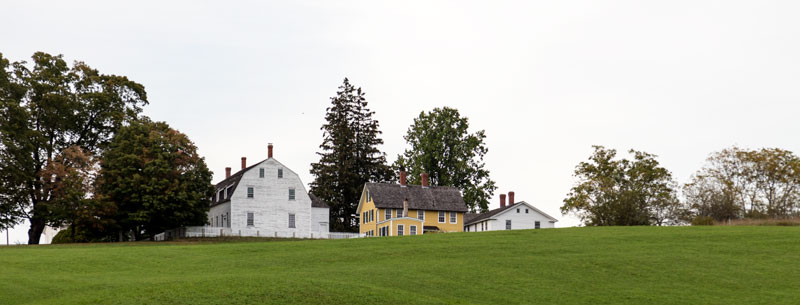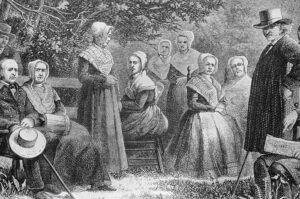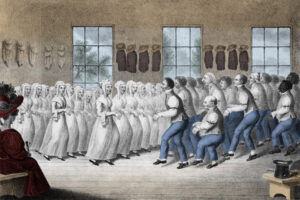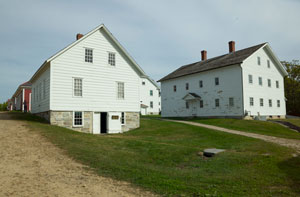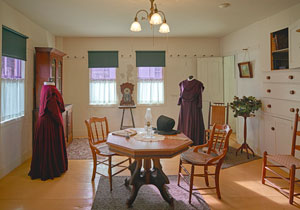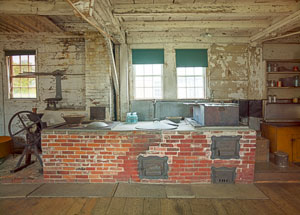Canterbury Shaker Village, in New Hampshire, is one of several Shaker communities founded in the 19th century. The historic site is one of the most intact and authentic surviving Shaker communities.
The Shakers are a sect of Christianity that trace their beginnings to Manchester, England, in 1747. They called themselves The United Society of Believers in Christ’s Second Appearing. However, they became known as Shakers because they trembled, whirled, and shook during ecstatic worship services.
Shaker societies were characterized by communal living, productive labor, celibacy, pacifism, and gender equality. They were also associated with feminist and abolitionist reform movements in the 19th century. A significant portion of Shakerism was founded in England by Mother Ann Lee in 1758 and was imported to America by Lee and several followers in 1774.
In 1782 Israel Chauncey and Ebeneezer Cooley from the Mount Lebanon village of Shakers in New Lebanon, New York, traveled to Canterbury, New Hampshire, and converted several prominent figures of the community. The seventh Shaker community, Canterbury Village, was founded in 1792 and led by Father Job Bishop through a donation of land from local community members. The village expanded over time, and in 1803 there were 159 members in three families.
The Shakers believed in community ownership but were aggressive entrepreneurs, launching industry after industry, developing and adopting new technologies, and reinvesting the earnings into community enterprises to encourage greater growth and productivity. At their height, they were highly successful in competing with the outside world. By the 1830s, the Shakers at Canterbury were rich in buildings, land, cash, wood lots, livestock, produce, industry, community possessions, and community skills. The Shaker “brand” quickly became known for quality, integrity, and reliability. Shakers cared for the poor and used resources and profit for social good.
Canterbury resembled most other Shaker villages built at the same time. It had all the principal buildings required of a strictly utilitarian communal society, including dwelling houses, shops, stables, laundry, a school, and an infirmary. The Meeting House, designed by Moses Johnson, played a primary role in the day-to-day functioning of the community.
Eventually, the Shakers established 19 self-contained communities from Maine to Kentucky. Canterbury Shaker Village is one of the oldest, most typical, and most completely preserved Shaker villages. The Village contains the oldest Moses Johnson-style Meeting House in its original location, built in 1792, and the only 18th-century Dwelling House that began in 1793.
The Canterbury Shaker population peaked at 300 in 1850. By the time the Civil War began, 6,000 shakers maintained economic autonomy while making items for outside commercial distribution. Their agrarian work was eventually redirected to handicrafts, particularly furniture. Over the years, various inventions from mainstream society were adopted by its members. These included new means of transportation, power sources, complex machinery, and communication devices.
After the war and subsequent Industrial Revolution, Shakerism went into severe decline. The newly industrialized economy made it difficult for them to compete, and waning prosperity made it difficult to recruit converts. As the number of living Shakers diminished, Shaker communities were disbanded.
In 1901 the New England Telephone Company installed telephones at the Canterbury Village site. This eliminated the need for most long-distance travel between Shaker communities.
In 1905, there were 100 members. In 1910, the village constructed its powerhouse for $8,000, which powered the electric lights in 16 community buildings.
By 1916, the Shakers in Canterbury had dwindled to just 49, 47 women and two men. There were also 12 females under the age of 21 and one non-Shaker living in the village for seven years.
The last male member of the Canterbury Village, Brother Irving Greenwood, died in 1939.
In 1947, when LIFE magazine reporter Nina Leen visited the village, there were 16 sisters remaining, ranging in age from 43 to 80.
In 1957, after “months of prayer,” the community leaders of Canterbury voted to close the Shaker Covenant.
In the early 1980s, Canterbury Shaker Village opened to visitors as a historic site, with tours, greetings by some of the remaining Shakers, and a gift shop.
In 1988, Eldress Gertrude Soule died, leaving only two Shakers at Canterbury Village. Bertha Lindsay, the last Shaker eldress, died on October 3, 1990, leaving only one Shaker at Canterbury, Sister Ethel Hudson. By September 1992, she had died at the age of 96.
That year, the Village began to operate exclusively as a museum. It was declared a National Historic Landmark in 1993.
Today, the museum at Canterbury interprets 200 years of Shaker life through its exhibits, buildings, gardens, programs, and tours. The museum has an enviable collection of Shaker objects, manuscripts, and photographs, along with surviving architecture from all periods of its history. Canterbury Shaker Village is a unique resource for learning about Shaker architectural intent, early Shaker community planning, design, and the many periods of Shaker life. The postcard-perfect setting hosts tens of thousands of visitors each year, making it one of New Hampshire’s most popular cultural attractions.
The site is operated by a non-profit organization established in 1969 to preserve the heritage of the Canterbury Shakers. The historic site displays 25 original Shaker buildings, four reconstructed Shaker buildings, and 694 acres of forests, fields, gardens, and mill ponds. Village staff, primarily volunteers, conduct tours.
Canterbury Shaker Village is located at 288 Shaker Road in Canterbury, New Hampshire. The outdoor museum features guided tours, craft demonstrations, and restored organic gardens. Among the buildings open for tours are the Meeting House, Laundry, Ministry, Sisters’ Shop, School, Dwelling House, School House, and North Shop. There is an admission fee.
More Information:
Canterbury Shaker Village
288 Shaker Road
Canterbury, New Hampshire 03224
603-783-9511
Also See:
Immigration to the United States
Sources:

